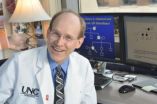(Press-News.org) Let algae do the dirty work.
Researchers at Rochester Institute of Technology are developing biodiesel from microalgae grown in wastewater. The project is doubly "green" because algae consume nitrates and phosphates and reduce bacteria and toxins in the water. The end result: clean wastewater and stock for a promising biofuel.
The purified wastewater can be channeled back into receiving bodies of water at treatment plants, while the biodiesel can fuel buses, construction vehicles and farm equipment. Algae could replace diesel's telltale black puffs of exhaust with cleaner emissions low in the sulfur and particulates that accompany fossil fuels.
Algae have a lot of advantages. They are cheaper and faster to grow than corn, which requires nutrient-rich soil, fertilizer and insecticide. Factor in the fuel used to harvest and transport corn and ethanol starts to look complicated.
In contrast, algae are much simpler organisms. They use photosynthesis to convert sunlight into energy. They need only water—ponds or tanks to grow in—sunlight and carbon dioxide.
"Algae—as a renewable feedstock—grow a lot quicker than crops of corn or soybeans," says Eric Lannan, who is working on his master's degree in mechanical engineering at RIT. "We can start a new batch of algae about every seven days. It's a more continuous source that could offset 50 percent of our total gas use for equipment that uses diesel."
Cold weather is an issue for biodiesel fuels.
"The one big drawback is that biodiesel does freeze at a higher temperature," says Jeff Lodge, associate professor of biological sciences at RIT. "It doesn't matter what kind of diesel fuel you have, if it gets too cold, the engine's not starting. It gels up. It's possible to blend various types of biodiesel—algae derived with soybeans or some other type—to generate a biodiesel with a more favorable pour point that flows easily."
Lannan's graduate research in biofuels led him to Lodge's biology lab. With the help of chemistry major Emily Young, they isolated and extracted valuable fats, or lipids, algae produce and yielded tiny amounts of a golden-colored biodiesel. They are growing the alga strain Scenedesmus, a single-cell organism, using wastewater from the Frank E. Van Lare Wastewater Treatment Plant in Irondequoit, N.Y.
"It's key to what we're doing here," Lodge says. "Algae will take out all the ammonia—99 percent—88 percent of the nitrate and 99 percent of the phosphate from the wastewater — all those nutrients you worry about dumping into the receiving water. In three to five days, pathogens are gone. We've got data to show that the coliform counts are dramatically reduced below the level that's allowed to go out into Lake Ontario."
Lodge and Lannan ramped up their algae production from 30 gallons of wastewater in a lab at RIT to 100 gallons in a 4-foot-by-7-foot long tank at Environmental Energy Technologies, an RIT spinoff. Lannan's graduate thesis advisor Ali Ogut, professor of mechanical engineering, is the company's president and CTO. In the spring, the researchers will build a mobile greenhouse at the Irondequoit wastewater treatment plant and scale up production to as much as 1,000 gallons of wastewater.
Northern Biodiesel, located in Wayne County, will purify the lipids from the algae and convert them into biodiesel for the RIT researchers.
### END
The green machine: Algae clean wastewater, convert to biodiesel
RIT researchers take algae out of the lab
2011-02-18
ELSE PRESS RELEASES FROM THIS DATE:
Study reinforces link between obesity, high-fat meals and heart disease
2011-02-18
The effect of a high-fat meal on blood vessel walls can vary among individuals depending on factors such as their waist size and triglyceride levels, suggests new research at UC Davis.
The new research reinforces the link between belly fat, inflammation and thickening of the arterial linings that can lead to heart disease and strokes.
Triglycerides are types of fat molecules, commonly associated with "bad cholesterol," known to increase risk of inflammation of the endothelium, the layer of cells that lines arteries.
"The new study shows that eating a common fast food ...
Magma power for geothermal energy?
2011-02-18
When a team of scientists drilling near an Icelandic volcano hit magma in 2009, they had to abandon their planned experiments on geothermal energy. But the mishap could point the way to an alternative source of geothermal power.
"Because we drilled into magma, this borehole could now be a really high-quality geothermal well," said Peter Schiffmann, professor of geology at UC Davis and a member of the research team along with fellow UC Davis geology professor Robert Zierenberg and UC Davis graduate student Naomi Marks. The project was led by Wilfred Elders, a geology professor ...
The NIST role in role-based control: A 20th anniversary appraisal
2011-02-18
What NIST-led innovation is estimated to have saved U.S. industry $6.1 billion over the past 20 years? Well, probably several, but, perhaps surprisingly, a new economics study* points to the development of "role-based access control," a computer-security technology fostered and championed by the National Institute of Standards and Technology (NIST) in the 1990s.
Role-based access control (RBAC) is the idea of establishing standard levels of access—"permissions"— to the various computing resources and networks of an organization that are tailored to specific employee roles, ...
Compact high-temperature superconducting cables demonstrated at NIST
2011-02-18
A researcher at the National Institute of Standards and Technology (NIST) has invented a method of making high-temperature superconducting (HTS) cables that are thinner and more flexible than demonstration HTS cables now installed in the electric power grid while carrying the same or more current. The compact cables could be used in the electric grid as well as scientific and medical equipment and may enable HTS power transmission for military applications.
Described in a paper just published online,* the new method involves winding multiple HTS-coated conductors** around ...
Promise of genomics research needs a realistic view
2011-02-18
CHAPEL HILL, N.C. - In the ten years since the human genetic code was mapped, expectations among scientists, health care industry, policy makers, and the public have remained high concerning the promise of genomics research for improving health.
But a new commentary by four internationally prominent genetic medicine and bioethics experts cautions against the dangers of inflated expectations – an unsustainable genomic bubble – and it offers ways to avoid it while still realizing "the true – and considerable – promise of the genomic revolution."
"This commentary is ...
Technology breakthrough fuels laptops and phones, recharges scientist's 60-year career
2011-02-18
EAST LANSING, Mich. — How does a scientist fuel his enthusiasm for chemistry after 60 years?
By discovering a new energy source, of course.
This week, SiGNa Chemistry Inc. unveiled its new hydrogen cartridges, which provide energy to fuel cells designed to recharge cell phones, laptops and GPS units. The green power source is geared toward outdoor enthusiasts as well as residents of the Third World, where electricity in homes is considered a luxury.
"SiGNa has created an inherently-safe solution to produce electric power, resulting in an eco-friendly and cost-effective ...
Asthma tied to bacterial communities in the airway
2011-02-18
Asthma may have a surprising relationship with the composition of the species of bacteria that inhabit bronchial airways, a finding that could suggest new treatment or even potential cures for the common inflammatory disease, according to a new UCSF-led study.
Using new detection methods, researchers learned that the diversity of microbes inside the respiratory tract is far vaster than previously suspected – creating a complex and inter-connected microbial neighborhood that appears to be associated with asthma, and akin to what has also been found in inflammatory bowel ...
Mayo researchers, Rochester educators, students to present at science conference
2011-02-18
ROCHESTER, Minn. -- America's largest general science conference will be the setting next week for seven presentations on how zebrafish changed the classroom in Rochester. Those presenting at the conference in Washington, D.C., include researchers from Mayo Clinic and Winona State University, educators from the Rochester school system, and several students.
"We started out trying to improve how science was taught. That led to adding curriculum beyond science, and resulted in improvement in testing and grade outcomes, and now to the experience of reporting all of it at ...
Inexpensive rinsing effective at reducing post-op infection following joint replacement surgery
2011-02-18
CHICAGO – A rinsing technique with betadine that costs just a little over one dollar per patient may significantly reduce the infection rate following total knee and hip joint replacement surgery according to a study by researchers at Rush University Medical Center.
The study, presented at the American Association of Orthopedic Surgeons 2011 Annual Meeting, found that a three minute diluted betadine lavage combined with painting of the skin with a 10% betadine solution prior to surgical closure nearly eliminated early deep post-operative infection.
Deep periprosthetic ...
Canadian brainpower at AAAS in Washington
2011-02-18
Washington (February 17) — Three leading Canadian language and speech experts will take centre stage in discussions on the latest developments in speech research at this year's annual meeting of the American Association for the Advancement of Science in Washington, D.C. (February 17-21).
Ellen Bialystok of York University has been a driving force in revealing the unique window that bilingualism opens on brain function. Her research disproves earlier claims of cognitive deficits among bilingual children, discovering, instead, that bilingual children and adults have distinct ...
LAST 30 PRESS RELEASES:
Sleeping in on weekends may help boost teens’ mental health
Study: Teens use cellphones for an hour a day at school
After more than two years of war, Palestinian children are hungry, denied education and “like the living dead”
The untold story of life with Prader-Willi syndrome - according to the siblings who live it
How the parasite that ‘gave up sex’ found more hosts – and why its victory won’t last
When is it time to jump? The boiling frog problem of AI use in physics education
Twitter data reveals partisan divide in understanding why pollen season's getting worse
AI is quick but risky for updating old software
Revolutionizing biosecurity: new multi-omics framework to transform invasive species management
From ancient herb to modern medicine: new review unveils the multi-targeted healing potential of Borago officinalis
Building a global scientific community: Biological Diversity Journal announces dual recruitment of Editorial Board and Youth Editorial Board members
Microbes that break down antibiotics help protect ecosystems under drug pollution
Smart biochar that remembers pollutants offers a new way to clean water and recycle biomass
Rice genes matter more than domestication in shaping plant microbiomes
Ticking time bomb: Some farmers report as many as 70 tick encounters over a 6-month period
Turning garden and crop waste into plastics
Scientists discover ‘platypus galaxies’ in the early universe
Seeing thyroid cancer in a new light: when AI meets label-free imaging in the operating room
Neutrophil-to-lymphocyte ratio may aid risk stratification in depressive disorder
2026 Seismological Society of America Annual Meeting
AI-powered ECG analysis offers promising path for early detection of chronic obstructive pulmonary disease, says Mount Sinai researchers
GIMM uncovers flaws in lab-grown heart cells and paves the way for improved treatments
Cracking the evolutionary code of sleep
Medications could help the aging brain cope with surgery, memory impairment
Back pain linked to worse sleep years later in men over 65, according to study
CDC urges ‘shared decision-making’ on some childhood vaccines; many unclear about what that means
New research finds that an ‘equal treatment’ approach to economic opportunity advertising can backfire
Researchers create shape-shifting, self-navigating microparticles
Science army mobilizes to map US soil microbiome
Researchers develop new tools to turn grain crops into biosensors
[Press-News.org] The green machine: Algae clean wastewater, convert to biodieselRIT researchers take algae out of the lab

